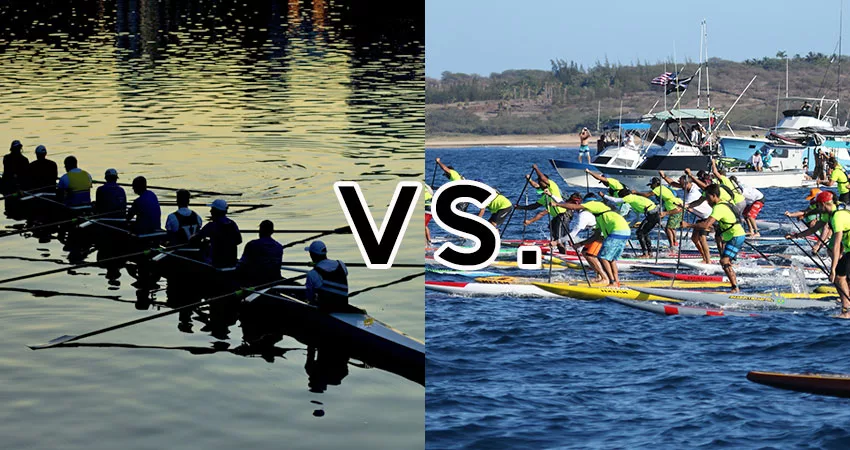We regularly receive requests from SEO agencies who want to place articles on Stand Up Magazine to link to betting or crypto sites. However, we turn most of these agencies down – such content has no place with us.
There are always cases in which the authors agree with us on a topic relevant to water sports. However, as we cannot live on air and love, the agency pays a small amount to Stand Up Magazine in such cases. This was actually the case with the article below. However, when it came to releasing the article and sending the invoice to the agency, we were ghosted for weeks.
As the work had already been done and the story also offered an interesting angle on paddling and rowing sports, we decided to publish the article either way – but without SEO links.
What do you think?
What paddle sports can learn from the competitive advantage of rowing

Imagine the following: It’s a misty morning on the river. Birds are chirping, the water is smooth as silk, and someone shouts “Pull! Pull!” as if their life depended on it. Welcome to the strictly disciplined, strangely glamorous world of rowing – a sport where bloody hands and synchronized power strokes are badges of honour. In paddle sports on the other hand – think kayaking, canoeing, SUP – there’s a great atmosphere but it’s very relaxed, perhaps lacking a little of the razor-sharp edge that rowing brings?
Don’t get us wrong: paddle sports are great. They offer nature, freedom and a laid-back vibe that will make you an Instagram hit. But while paddlers are sipping electrolyte smoothies on a sun-drenched lake, rowers are charging towards the Olympics with military precision and stopwatches. And this is where the lesson begins.
Rowing: The boot camp of water sports
Rowers have a work ethic that would make even Navy SEALs blush. Athletes in this sport don’t “just paddle”. They toil. They get up at 5 a.m., live in Lycra and treat milliseconds like treasure. Their training program includes insane cardio workouts, Olympic weightlifting and more ergometer sessions than any normal person should endure. And it shows.
Rowing has established itself as a competitive sport. Regattas are well organized, the teams are disciplined and there is a clear and ambitious path from beginner to elite athlete. Compare that to paddle sports, which are sometimes more like a chilled-out club with snacks brought in. Of course, this relaxed culture is a big part of the appeal – but it’s also the reason why these sports don’t get the same recognition and promotion. Paddle sports could take a leaf out of rowing’s book. Imagine a kayak sprint league with team uniforms and cheering fans. Or a SUP time trial series where paddlers chase each other across the bay like in a Bond movie. The basis is there, all that’s missing is a little gloss.
Betting on paddles: The curious case of betting and water
This is where it gets exciting. We might not associate sports betting with rowing or paddle sports, but you know what? Betting has become a major factor for visibility in all kinds of sports – even those that don’t involve balls or stadium seats.
Rowing has quietly found its way onto betting platforms, especially for high-profile races such as the Oxford-Cambridge Boat Race or the World Rowing Championships. Gambling not only keeps fans excited, but also increases the sport’s exposure, attracts sponsors and provides much-needed revenue.
Paddle sports could also benefit from this wave. Imagine betting odds for SUP duels or canoe slalom races. A little betting fever could electrify the competitions and attract spectators who don’t know an oar from a sandwich but love the thrill of gambling. Of course, this requires a certain framework – regulations, fairness and probably some fancy betting apps that don’t look like they were designed in 2008.
Paddling with purpose: the need for structure and spectacle
One of rowing’s secret weapons is its infrastructure. Clubs supply schools, which in turn supply national programs. They all follow a path so structured that it might as well be written down in spreadsheets. This not only produces top athletes, but also lifelong fans. There is continuity. A history. And security.
Paddle sports, on the other hand, can feel like an adventure book where you are in charge of the plot. This is great for personal adventures, but not so good for building an audience or retaining competitive talent. With a little structure – such as national rankings, official clubs and league-style competitions – paddle sports could utilize the same dynamic. But hey, let’s not discount the charm, because paddle sports have plenty of personality. While rowing is all about discipline and uniformity, paddle sports are colorful and imaginative.
There is something rebellious about a sport where people stick GoPros to their helmets and paddle down waterfalls. The trick is to combine this raw creativity with the strategic component of rowing. Add sponsors, streaming contracts and a commentator who can pronounce “outrigger canoe” without breaking his tongue, and you have a sport that is not only fun, but also impressive.
Concluding thoughts
So what can paddle sports learn from rowing? Quite a lot, actually. From structured training and the integration of strategic bets to solid competition, there is plenty of room for further development without losing the wild, wonderful core of paddling.
Rowing brings the excitement, paddle sports bring the soul. Together they could swim into a new golden era of watersports glory – one paddle stroke and perhaps one bet at a time.
